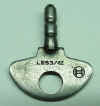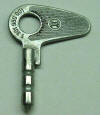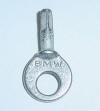|
BMW motorcycle headlight/ignition switch and keys for the /2 and /5 |
|
The headlight and ignition switches that have been used since the 30's, and up till the end of the /5, take some care and maintenance. Used properly, they will last for many years. Here are the things that go wrong. Have I forgotten some? Email me to let me know. 1. The chrome cover plate gets scratched up from riders who use the key in one hand to slide the black plastic forwards to make a space to insert the key. Use both hands. 2. The round brass place has the hole for the key also has a slot for turning on and off the headlight. It gets "wallowed out" from riders "pounding" the key into place with the palm of the hand. Never "hit" the key into place. 3. The black plastic rain cover breaks off earlier than necessary. This is because riders use the tip of the key to push it forwards. One should use two hands to insert the key. Pull the black plastic forwards with one hand while the other gently inserts the key. See it below. Insert it and gently wiggle down and into place. 4. The key goes in only with some effort, because it lacks lubrication. Inside are two ball bearings that are held in place with a small spring that wraps around and holds the balls in place. The balls are the detents that drop into the grooves in the key to hold it down. If the balls and spring lack oil, then it is hard to get into place. One must really press on it and that causes the keyway to get wallowed out. A drop of oil, once a year, is enough. 5. Headlight shells get badly scratched by the use of the flat metal (emergency) key. It is often kept on a key chain and when needed, is used while still on the key chain. The "extra" keys flop around and chip the paint. Use the flat key all by itself. 6. The key can't quite be pushed far enough to keep the contact. One feels the need for a longer key or a large rubber band to hold it down. Over time one of two things can happen. The whole switch assembly can become slightly loose and/or the contact points in front can become misaligned. How to use the black plastic BMW motorcycle ignition keyWhen the key has been left in the "half in-half out" position, it is tempting to just "bang" it into place. It will cause the keyway that turns the headlight switch to wallow out the narrow slot that it should fit into. The above photo of an old headlight shell is of the round hole that the ignition key plugs into. The black plastic slider is broken and gone. The bottom of the photo is the front of the shell. See the notch for the keyway at the upper part? It is twice as wide as the one below the hole. That is because the key has been "hammered" in and that "wallowed out" the keyway. The upper notch, or rear one, was once identical to the front or lower one. With this extra slop, the key may no longer turn the internal parts far enough to make contact. If this has happened to your switch already, as a temporary measure, you can just turn the key backwards. For a permanent fix, one must remove and rotate the round part so that the key will now engage the "virgin" slot that has been facing the front. Photo by Jeff Kuzmanoff, thanks See the cut away arc (about 10 O'clock to 2 O'clock) where the sheet metal has been removed? The "outer part" with the missing arc is essentially the limit for rotating the key for the headlight and parking light switch portion of the assembly. That must be done on the bottom side too. To do this requires removing the entire switch plate, remove and modify the part shown and reinstalling it 180 degrees from where it was. This isn't a nice job as the switch plate is held in with 4 bend-over tabs of metal. With age these tabs become brittle. These tabs will only tolerate a few bendings and then break off. I use a short screwdriver to bend the tab. The chrome cover also is held on with bend-over tabs. The ultimate life of the whole assembly is determined by the tabs, which means the owner must use care. It has been reported that one can soften the tabs by heating them up to about red and then allowing them to cool slowly. I have never tried it, but it sounds correct. One may need to replace the black plastic slider that keeps rain out of the round hole and headlight. All work can be done while the headlight is on the bike. It may help to remove the speedometer to get enough room to work. The switch plate must be lowered and the chrome cover lifted. The 4 tabs should only be bent the least amount needed to loosen the chrome cover enough to get the broken parts out and install the new ones. I have heard of mechanics being able to thread a wire around the post and grabbing the spring. This would avoid the above mentioning of bending the tabs. This would be great, but I have never done it. Let me know or put it up on your site and tell is about it. Please. About the headlight switch plateThis is the headlight and ignition switch plate. Look for the 4 slotted holes that are all at a 45 degree angle and near the corners. The slots are for the 4 bend over tabs to go into. The curved lower part has the three detents for the light switch. On the other side of the plate are several terminal posts that hold wires. The screws that hold them do come loose. Once a year check them for tightness with a small slotted screwdriver. Here is the switch plate as you would see it in the headlight shell. In between the yellow terminals are the two horizontal brass plates. They are the contacts for the ignition. The upper one is all the way up. This is how it looks with the key out, which is ignition OFF. Now you can see the contact as it would look with the key down, which is ignition ON. It has a little tit, not seen here due to poor lighting, that contacts the lower arm. On the /2 it need not actually contact the lower one to allow the engine to start. Once it has moved down a tiny bit, it has broken the contact that grounds the magneto. The red/green lights wouldn't be on, but it will start and run. If it fails to stop when the key is removed, then it is most likely that the entire switch plate is slightly loose. On the /5, the two must actually make contact to get power to the ignition system. It will start only when you see both (several) lights lit up. In this case you can see that the lower contact isn't quite level. It is bent up just a tiny bit. That was probably done so that the two would make contact. It may need to be done when one finds that the key must be held down to get the lights to stay on. Bend this very gently and only a bit at a time, until it is just right. The other reason that it might be bent upwards is that the whole plate could be loose and therefore lower than normal. If that is the case, bend the tabs up a bit more to hold it better. I would try bending only two and only the amount needed to hold it mounted firmly. If needed, I would bend all four of them. If you are having trouble keeping the key operating correctly, read below about the key.Warning! Do not bend the actual spring, only the arm or tabs.Here is the plate mounted in a /5 shell, but this part is almost the same for a /2. As time went on, 55-73, the switch plate became slightly more complicated, with a couple of more terminals. The various keysLate 30's to 55 black plastic "normal" key Late 30's to 55 flat key, for use on a key ring. This is the black plastic "normal" key. The first model to use this key was the R25/3. It was standard on all of the Earles fork models 55-69 and the /5 series 1970-73. Some of the keys offered today are not made correctly. Some are too short and don't operate the switch properly. Some have the groove for the ball detent in the wrong place. Make sure that your key is correctly made. 55 through 73 flat key, for use on a key ring. BMW motorcycle theftDo these keys all look alike? There is only one "key" and it fits all BMW's. The 55-69 type will work in the older bikes, but they stick up too far. All a thief needs to do, to steal a /2, is to remove the ground from the magneto. This can be accomplished, in seconds, by cutting the whole harness. The /5 and /6 can be started by adding a jumper, a simple wire with alligator clips. It only takes a few seconds. The fork lock can be defeated in a few minutes. Your bike is easy to steal, so aren't you glad that BMW's aren't "cool" and fast? Be glad for that "stodgy image." The black plastic rain cover (slider)The black plastic rain cover breaks and is unavailable. A repro is available, but it is slightly different and you can see the very small differences. These were sent to me by Lonnie to photograph for your information, thanks so much. I do appreciate all that Lonnie and others have done to improve this site. The weight is slightly different; new is 2.95 grams and the old one is 4.4 grams. Both have a diameter of the pins that hold the spring to within .001" but the new one has better quality control over it's roundness. The old one is actually old and not shiny any longer. The new one is very shiny. I hope that the photos show the several small differences in the molds, of which none are important. The main difference I can tell is the new one is far more flexible. It has been noticed that when installed it can be pulled out forwards and then lifted up about 1/2". On the right picture the old one shows considerable wear on the place where the plastic rubs the key shank. The new one shows a "V" shape and it is rounded on the old one. In normal proper use the repo is great. The old black plastic covers are shown on the left and the new ones on the right. The new ones are far more flexible than the original ones. This should reduce the tendency for the ends to break off. Trivia timeThis is the key for opening the tool box on the top of many gas tanks from
the early 30's to the mid 70's. It has a square end, but the proper sized
slot screwdriver works just great. Many riders seldom used the key to open
and close the lid. Just push down on the cover to compress the thick
rubber gasket and hand screw the round fastener in only finger tight. Let
go of the pressure and the "lock" is quite tight. To unlock it, just
compress it again and turn it out with your fingers. |
|
This page was last edited:
10/04/2006 - copyright
Duane Ausherman |










